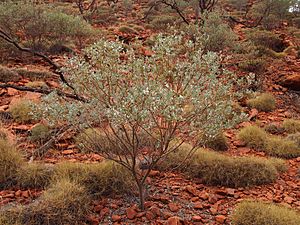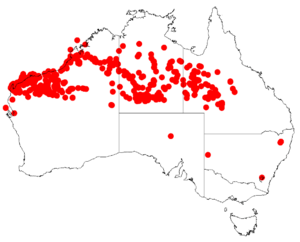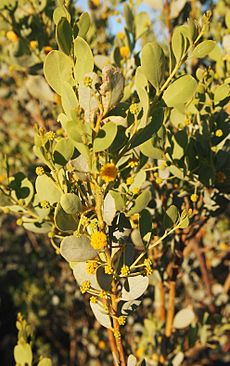Two-nerved wattle facts for kids
Quick facts for kids Two nerved wattle |
|
|---|---|
 |
|
| Scientific classification | |
| Genus: |
Acacia
|
| Species: |
bivenosa
|
 |
|
| Occurrence data from AVH | |
The Acacia bivenosa, often called two-nerved wattle, two-veined wattle, or hill umbrella bush, is a type of Acacia plant. You can find it growing across northern Australia.
This plant has many names! Some come from different Australian Aboriginal languages. For example, the Kurrama people call it murrurpa, murrurbaor, or morama. The Panyjima people know it as mururru, and the Nyangumarta call it mururr.
What it Looks Like
This wattle is a bushy plant that usually grows between 1 and 3 meters (about 3 to 10 feet) tall. Sometimes it can even reach 5 meters (about 16 feet) high and spread out to 3 meters wide. Its bark is smooth and light grey.
The leaves, which are actually flattened leaf stems called phyllodes, are long and narrow. They can be from 2 to 7 centimeters (about 1 to 3 inches) long and 6 to 20 millimeters (about 0.2 to 0.8 inches) wide.
From April to November, the plant blooms with bright yellow flowers. These flowers grow in round clusters, about 10 millimeters (0.4 inches) across. Each cluster holds 16 to 32 small, golden flowers.
After the flowers, light brown, woody seed pods appear. These pods are straight or slightly curved. They can be 2 to 10 centimeters (about 1 to 4 inches) long and 5 to 9 millimeters (about 0.2 to 0.4 inches) wide. Inside, you'll find shiny, dark brown to black seeds. Each seed is about 4 to 6 millimeters long and has a red or orange cap called an aril.
How it Got its Name
The Two-nerved wattle was first officially described by a botanist named Augustin Pyramus de Candolle in 1825.
Over time, this plant has had a few different scientific names, like Acacia elliptica or Acacia binervosa. For a short time in 2003, it was called Racosperma bivenosum, but by 2006, it was changed back to its current name, Acacia bivenosa.
Where it Grows
You can find the Two-nerved wattle across the dry, or arid, parts of northern Australia. It's very common in the Pilbara and Kimberley areas of Western Australia. It also grows in the Northern Territory and western Queensland. There's even a small group of these plants on Dorre Island in Shark Bay, Western Australia.
This wattle can grow in many different places. It likes coastal sand, rocky hills, and even gullies. You'll often see it in shrublands and open woodlands, sometimes growing near a spiky grass called spinifex.
Uses of the Two-nerved Wattle
This bush can be eaten by farm animals, especially when it's a young plant.
Long ago, Indigenous Australian people would find edible grubs (insect larvae) living around the roots of this plant.
Today, the Two-nerved wattle is often used to help fix damaged land. It's one of the first plants to grow in an area that needs to be restored.
You can also buy seeds of this plant to grow in gardens, especially in dry areas.



